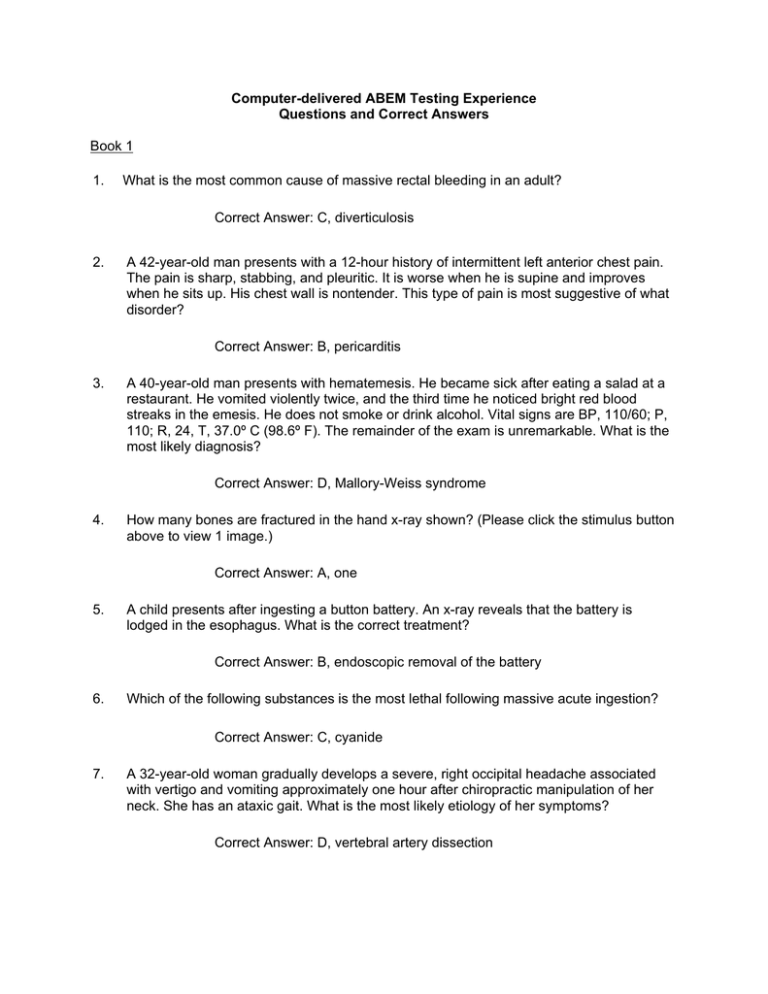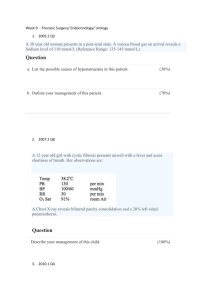answers to the demonstration
advertisement

Computer-delivered ABEM Testing Experience Questions and Correct Answers Book 1 1. What is the most common cause of massive rectal bleeding in an adult? Correct Answer: C, diverticulosis 2. A 42-year-old man presents with a 12-hour history of intermittent left anterior chest pain. The pain is sharp, stabbing, and pleuritic. It is worse when he is supine and improves when he sits up. His chest wall is nontender. This type of pain is most suggestive of what disorder? Correct Answer: B, pericarditis 3. A 40-year-old man presents with hematemesis. He became sick after eating a salad at a restaurant. He vomited violently twice, and the third time he noticed bright red blood streaks in the emesis. He does not smoke or drink alcohol. Vital signs are BP, 110/60; P, 110; R, 24, T, 37.0º C (98.6º F). The remainder of the exam is unremarkable. What is the most likely diagnosis? Correct Answer: D, Mallory-Weiss syndrome 4. How many bones are fractured in the hand x-ray shown? (Please click the stimulus button above to view 1 image.) Correct Answer: A, one 5. A child presents after ingesting a button battery. An x-ray reveals that the battery is lodged in the esophagus. What is the correct treatment? Correct Answer: B, endoscopic removal of the battery 6. Which of the following substances is the most lethal following massive acute ingestion? Correct Answer: C, cyanide 7. A 32-year-old woman gradually develops a severe, right occipital headache associated with vertigo and vomiting approximately one hour after chiropractic manipulation of her neck. She has an ataxic gait. What is the most likely etiology of her symptoms? Correct Answer: D, vertebral artery dissection 8. A 20-year-old man presents after developing a persistent dry cough, dyspnea with exertion, and a low-grade fever two days into a rapid mountain climbing ascent. Physical examination reveals him to be tachypneic at rest, cyanotic, and tachycardic. Diffuse rales are present on chest auscultation. Which of the following is the most likely diagnosis? Correct Answer: D, high altitude pulmonary edema 9. A patient with eclampsia is receiving an intravenous infusion of magnesium sulfate. To avoid toxicity, which of the following is the most important to monitor? Correct Answer: B, patellar reflexes 10. What type of rhythm is demonstrated in the video shown? (Please click the stimulus button above to view 1 video.) Correct Answer: B, sinus tachycardia Book 2 1. A 43-year-old man presents unconscious, vomiting, and in severe respiratory distress after spraying his garden. His pupils are 2 mm, he is very diaphoretic, and his lungs have diffuse crackles and rhonchi. Initial treatment includes which of the following? Correct Answer: B, atropine 2. What is the most common complication from a lumbar puncture? Correct Answer: B, headache 3. Which of the following substances is most likely associated with the rhythm strip shown? (Please click the stimulus button above to view 1 image.) Correct Answer: A, atropine 4. A 9-year-old boy presents with his parents who are concerned about his behavior. The boy insists on washing his hands every hour, even while at school. In addition, he checks all windows and doors throughout the house three times per day, and has been observed retracing his steps when walking home from school. What is the most likely diagnosis? Correct Answer: C, obsessive-compulsive disorder 5. Which of the following is demonstrated on the head CT scan shown? (Please click the stimulus button above to view 1 image.) Correct Answer: A, epidural hematoma 6. In which of the following situations should endotracheal intubation be performed in trauma patients? Correct Answer: C, Glasgow coma scale score of 8 or less 7. What otoscopic sign is the most sensitive for the presence of a middle ear effusion? Correct Answer: D, restricted movement of the tympanic membrane on insufflation 8. What test is most helpful in confirming a clinical suspicion of acute pancreatitis? Correct Answer: C, serum lipase 9. A 30-year-old woman presents after a motor vehicle crash. X-rays of her chest, pelvis, cervical, thoracic, and lumbar spine are normal. She is discharged. Two days later she returns to the ED with urinary incontinence and feeling that her bladder is always full. The examination only reveals loss of perineal sensation. A Foley catheter is placed and 800 mL of urine is obtained. A urinalysis is normal. Which of the following is the most appropriate management? Correct Answer: B, MRI scan of the lumbar spine 10. A 63-year-old man with a history of "borderline diabetes" presents with a one-day history of perineal and perianal pain, fever, and chills. He had dilatation of a chronic urethral stricture one day ago. On examination, he appears toxic with marked scrotal and perineal swelling, tenderness, and crepitus. Which of the following is the most appropriate management? Correct Answer: B, immediate surgical debridement 11. During insertion of a central venous pressure (CVP) catheter in a stable patient by the left subclavian route, the nurse notices premature ventricular contractions (PVCs) on the cardiac monitor. What should be the immediate course of action? Correct Answer: D, pull back the CVP catheter and recheck monitor 12. A 63-year-old man who sustained a puncture wound to his right foot six days ago presents with pain and stiffness in his masseter muscles. What is the most appropriate management? Correct Answer: C, admit to the medical ICU 13. A 20-year-old woman presents with the sudden onset of severe mouth pain four days after extraction of four wisdom teeth. Examination of the extraction sites reveals no hemorrhage or inflammation. Which of the following is the most likely cause of the pain? Correct Answer: B, alveolar osteitis 14. A 45-year-old depressed woman presents with a long history of headaches, irritable bowel, poor sleep, and generalized body pain. Examination reveals multiple tender areas over the back and extremities. What is the most likely diagnosis? Correct Answer: C, fibromyalgia 15. Which of the following is the mainstay of treatment for serious gamma-hydroxybutyrate (GHB) overdose? Correct Answer: D, respiratory support
